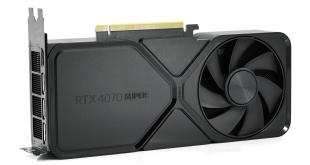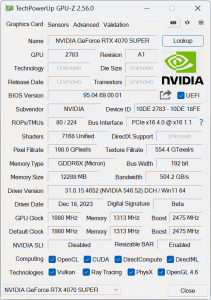
Hot on the heels of its announcement at CES 2024, today we can present our review of Nvidia's RTX 4070 Super GPU. Offering 22% more cores than the original RTX 4070 while arriving at the same price point, on paper this looks like an enticing refresh of what was already considered one of the better RTX 40-series GPUs. Today we find out if the 4070 Super is as good as it sounds, or whether or not there is more to the story…
Casting our minds back to April 2023 and the release of the RTX 4070, at the time we praised the GPU for its efficiency gains and decent performance at 1440p, but it's fair to say we weren't blown away by the generational gains on offer. Fast forward to today and Nvidia is claiming 15% better performance with the new RTX 4070 Super, and at the same price (£579/$599) to boot.
The increased core-count is more-or-less the only change, so if you were hoping for more VRAM or a wider memory interface on a xx70 SKU, then you will have to hold out for the RTX 4070 Ti Super that launches next week. For now though, we have tested the 4070 Super over twelve games, plus another eight with ray tracing, so let's find out how it got on…
If you want to read this review as a single page, click HERE.
| RTX 4090 | RTX 4080 | RTX 4070 Ti | RTX 4070 Super | RTX 4070 | |
| Process | TSMC N4 | TSMC N4 | TSMC N4 | TSMC N4 | TSMC N4 |
| SMs | 128 | 76 | 60 | 56 | 46 |
| CUDA Cores | 16384 | 9728 | 7680 | 7168 | 5888 |
| Tensor Cores | 512 | 304 | 240 | 224 | 184 |
| RT Cores | 128 | 76 | 60 | 56 | 46 |
| Texture Units | 512 | 304 | 240 | 224 | 184 |
| ROPs | 176 | 112 | 80 | 80 | 64 |
| GPU Boost Clock | 2520 MHz | 2505 MHz | 2610 MHz | 2475 MHz | 2475 MHz |
| Memory Data Rate | 21 Gbps | 22.4 Gbps | 21 Gbps | 21 Gbps | 21 Gbps |
| L2 Cache | 73729 KB | 65536 KB | 49152 KB | 49152 KB | 36864 KB |
| Total Video Memory | 24GB GDDR6X | 16GB GDDR6X | 12GB GDDR6X | 12GB GDDR6X | 12GB GDDR6X |
| Memory Interface | 384-bit | 256-bit | 192-bit | 192-bit | 192-bit |
| Memory Bandwidth | 1008 GB/Sec | 716.8 GB/Sec | 504 GB/Sec | 504 GB/Sec | 504 GB/Sec |
| TGP | 450W | 320W | 285W | 220W | 200W |
First, a quick spec recap. Just like the RTX 4070 Ti and RTX 4070, the new 4070 Super uses a cut-down AD104 die, measuring 295mm2. The fundamental building blocks are still the same of course, with the RTX 4070 Super offering a total of 56 Streaming Multiprocessors (SMs), each housing 256 CUDA Cores, for a total of 7168. We also find 56 RT cores, 224 Tensor cores, 224 Texture Units, and 80 ROPs.
TSMC's N4 node has Nvidia cranking up the clock speed significantly this generation, with the RTX 4070 Super sporting the same 2475MHz rated boost clock as the original model. That's still 135MHz slower than the rated clock speed of the RTX 4070 Ti, but we would expect GPU Boost to push things further still.
The memory configuration also remains the same as both the 4070 and 4070 Ti. That means a relatively narrow 192-bit memory interface, so even with 12GB GDDR6X running at 21Gbps, total memory bandwidth comes in at 504 GB/s, lower than the RTX 3070 Ti. That said, there has been a substantial upgrade to the L2 cache with the Ada architecture, with the RTX 4070 now offering 49.1MB, compared to just 6MB for GA102.
Considering the increased core-count, power draw is naturally a touch higher than the RTX 4070, with the 4070 Super boasting a 220W TGP. This is something we focus on closely in this review, using our enhanced GPU power testing methodology, so read on for our most detailed power and efficiency testing yet.
 KitGuru KitGuru.net – Tech News | Hardware News | Hardware Reviews | IOS | Mobile | Gaming | Graphics Cards
KitGuru KitGuru.net – Tech News | Hardware News | Hardware Reviews | IOS | Mobile | Gaming | Graphics Cards



